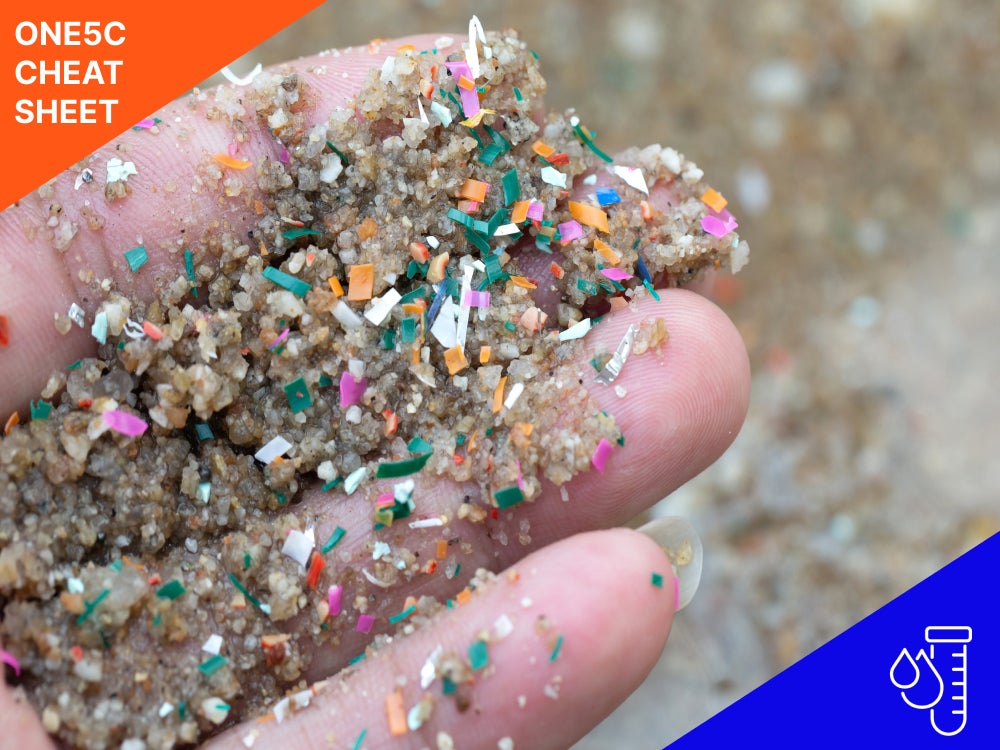Big chunks of plastic floating in the ocean might be the first image people conjure up when they think about plastic pollution, but those rafts of discarded water bottles are only the beginning. When it comes to the overall impact of plastic pollution, we should be talking more about microplastics. Microplastics are the sub-five-millimeter particles that make up 92% of the plastic on the ocean surface.1 Plus, the big blue deep is far from the only place affected by these treacherously tiny plastics: They’ve turned up in soil, tap water, food, and even our bodies.
There’s still more research to be done to figure out how microplastics impact the oceans, our health, and the planet—and if there’s anything we can do about it.
What are microplastics?
Pieces of plastic smaller than 5 millimeters (about the width of a pencil’s eraser) are considered microplastics. Those below 1 micrometer (you’ll see this abbreviated as “μm”), or 1,000 times smaller than a millimeter, are called nanoplastics. We encounter them in products we likely use every day: Microfibers are teeny tiny plastic threads that make up textiles like polyester, and microbeads are microplastics purposefully made for cleaning or beauty products (and have been outlawed in several countries).
How are microplastics formed?
The majority of microplastics aren’t designed to be that way. They come from the deterioration of larger plastic pieces: think bottles, bags, toys, shoes, tires, the whole lot. Plastic doesn’t really degrade the way a dead leaf does on your lawn; it just breaks down into smaller bits. This coming-apart can happen in a variety of ways: Macroplastics break down into microplastics due to environmental exposure, release them during the recycling or wastewater treatment process, or shed them from clothes during a washing cycle, and more. Then there are microplastics that are produced as microplastics from the get-go. These wee bits are often called “nurdles,” and they’re used as building blocks in other plastic products.
No industry is innocent from microplastic pollution, but the worst microplastics offenders tend to be plastic production, clothing and textiles, fishing, and agriculture.
Go deeper about the sources of microplastics
- Where microplastics come from
- Plastic pollution, by country
- Plastic pollution in the ocean
- The problems with plastic recycling
Are microplastics dangerous for people and the planet?
Microplastics can be found everywhere: the air we breathe, oceans, ice cores, rivers and lakes, tap water, soil, coffee, chocolate, seafood, breast milk—just to name a few. And much like their macroplastic forebears, there’s a lot we don’t know about how these plastics impact the planet, animals, and people. We do know, however, that the smaller a plastic is, the easier it slips into tiny spaces like blood vessels or a fish’s gills. Even if plastics somehow aren’t much of a worry, their additives like PFAS and flame retardants are known to be a danger to the environment and to cause health issues like hormone disruption and cancer in humans.
Humans can get exposed to microplastic pollution in a variety of ways, but the way we prepare and package food is a primary culprit. Drinks stored in plastic bottles, plastic film on chunks of mango, and microwaveable meal packaging all can pose a risk.
Go deeper about the impact of microplastic pollution
- Microplastics in humans
- Microplastics in food
- Why plastic is bad for the environment
- The truth about bioplastics
How can we avoid, reduce, and address microplastics?
Unfortunately, when it comes to cleaning up microplastics, there’s not a ton we can do. And since microplastics are present in pretty much all of the stuff we touch, breathe, drink, and eat, there’s not a great way to avoid them full-stop. However, minimizing our use of macroplastics helps keep future microplastics from forming to begin with. That means taking a stand against single-use packaging, bottles, bags, straws, and so on. Keeping our food and drinks away from plastic containers whenever we’re able to can also limit leaching of plastics and their nasty additives into our favorite grub. When it comes to clothes, natural materials are better if you want to limit the leakage of microfibers into our waterways.
Finally, getting on board with campaigns, boycotts, and protests that aim to slow the roll of plastic production and pollution is always necessary. The less new plastics out there, the less they’ll appear in our food, planet, and bodies.
Go deeper about microplastic solutions
- How to avoid microplastics
- How to reduce plastic use
- Plastic-eating mushrooms
- Plastic-eating bacteria
- Plastic-eating worms
- Microplastics in the marine environment: A review of their sources, distribution processes, uptake and exchange in ecosystems, Case Studies in Chemical and Environmental Engineering, Sep. 2020 ↩︎

